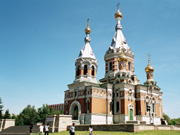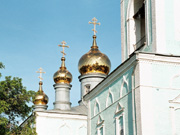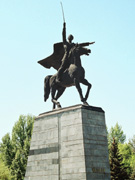| |
THE TIME OF JOLLY MISSIONS,
OR COMBINING BUSINESS AND PLEASURE
VOLNITSA OF URALSK
(Uralsk City)
Disobedience and craving for rebellions and revolutions seem to flutter above these lands. Mutinies were stirred up by Razin, Pugachev, Datov, Makhambet and Isatai, and this list can be enlarged further. I cannot help recalling the most well-known revolutionary, the hero of numerous anecdotes, Red Army man comrade Chapayev the monument to whom is established on the Privokzalnaya Square of the city.
|
Crossing of Furmanov and Red Army streets
|
On this very square Furmanov Street begins, from which one may turn to Krasnoarmeiskaya (Red Army) Street; then, walking along it up to the intersection with Oktyabrskaya, come along the latter to Frunze Street, and finish the excursion in Komsomolskaya Street. Perhaps, no other city in Kazakhstan has such a great number of street names now which may cause nostalgia of some people for 20 kopecks bread and trade-union vouchers to Yalta, or painful recollections of others about the omnivorous censorship and hated subbotniks. Uralsk communists keep a float better than their fellows in contemporary Kazakhstan, and it is obviously due to their efforts that the names of the streets still spread anachronism. Only iron Feliks (Dzerzhinskiy Avenue is now Eurasia Avenue) and grandfather Lenin (Druzhba-Dostyk Avenue at present) have not been safeguarded.
There are two main churches for the citizen of Uralsk – Zolotaya (Golden) and Staraya (Old). The former, the temple of Christ the Savior, has long ago become almost official symbol of the city, and its image is usually placed on most of materials connected with Uralsk . It was founded as far back as in 1891, with the participation of then crown prince, and later the Russian Emperor Nicolas II, when 300th anniversary of Uralsk Cossack Army’s serving to Russia was celebrated.
 |
|
It should be noted that almost everything is connected with the Cossacks and the Cossack Army in Uralsk . Until the Soviet power was established they were real proprietors of the city. To the present day Ataman’s house and Uralsk Army’s office building rank among the sights of the city, and in the local lore museum the Cossack theme is as widely exposed as no other one.
The southern edge of Uralsk which is actually its historical center is called ‘Kurens’. Kuren is a Cossack log house, and this peculiar district is built up by such constructions. Actually Kurens are well-known for two things: Pugachev museum and the old church – Mikhailo-Arkhangelskiy Cathedral. Due to its plain appearance, the old church is probably less famous than the glorious Golden Church, though its fate is much more interesting. The cathedral was built already in 1751, that is why its walls witnessed the Peasants’ War headed by Yemelyan Pugachev. In the Old Cathedral there is a crypt-grave of the priest whom Pugachev put to death for his refusal to marry him and Ustinya Kuznetsova. In Uralsk you will most likely be told that Pugachev threw the priest down off the bell tower of the Old Cathedral, but this is not quite true. In fact, the priest who refused to marry already married Pugachev perished after being thrown down off the bell tower of another church which has not been preserved up to our days. During the events described a thousand soldiers devoted to the Empress was sitting in the Old Cathedral in the state of siege. Despite starvation the soldiers stood their ground protected by the thick walls of the Cathedral for over 3 months, and Pugachev had to raise the siege. There is also an interesting but little-known fact that during the siege the commandant of the garrison Andrey Krylov was sitting within the precincts of the cathedral with his little son Vanya who later became the most famous Russian fabulist Ivan Krylov.
 |
Mikhailo-Arkhangelskiy Cathedral |
Lovers of history of the civil war can also have an excursion of the city: the houses in Uralsk abound in tables like ‘here in 1920 revolutionary military council was located’ and ‘in this house stayed Comrade Furmanov’. The history of Vasiliy Chapayev’s death attracts the greatest interest because the existing version of his death from White Guard bullet in the Ural river has been lately often called in question. There are opinions that the commander who had been by that time unfavorable for the Soviet Power, was not drowned in the Ural river but died a violent death in Uralsk and was buried not far from the Zolotaya Church (approximately in the place of what is now stadium ‘Yunost’).
 |
Chapayev monument |
This peculiar virtual excursion of the city may be finished in the Teatralnaya street, local pedestrian area also known as Arbat . It is here that one can on the largest scale observe one more point of interest in Uralsk – the girls. I am not the first and not the last to be delighted with how attractive are the women in the city. Not far from Arbat there is a cafe called ‘Dragon’ that became a kind of phantom for Sanya and me. We got there once after midnight accompanied by two female ‘points of interest’ of Uralsk and later, when sober-minded, in vain did we try to find it for several days (true, finally we did not dishonor the title of the members of the geographical society and found it).
In order not to be blamed for lop-sidedness and suppression of the facts I will tell that in Uralsk certainly exists a more modern part of the city, built up by not-attractive and alike many-storied constructions. But after I got there once I decided not to do that in future, so as not to spoil good impressions by mediocre ones.
I will not concentrate on our trip to the town of Aksai. Of course, I doubt that a foreign tourist, if he is of sound mind, will go there. But there are different situations and everything should be described. Therefore one day we decided to visit this rather big but absolutely industrial town, the location of which is, as they say, entirely worst. It was here that it occurred to me that our Central Kazakhstan steppe landscape is quite a bright picture (because it is alternated either by hills or by small rivers). What we saw here was only panel houses burnt by the heat and flat steppe which was more like desert. We spent a vain day in Aksai, and in the evening we again enjoyed green Uralsk streets and delights of local architecture.
|



